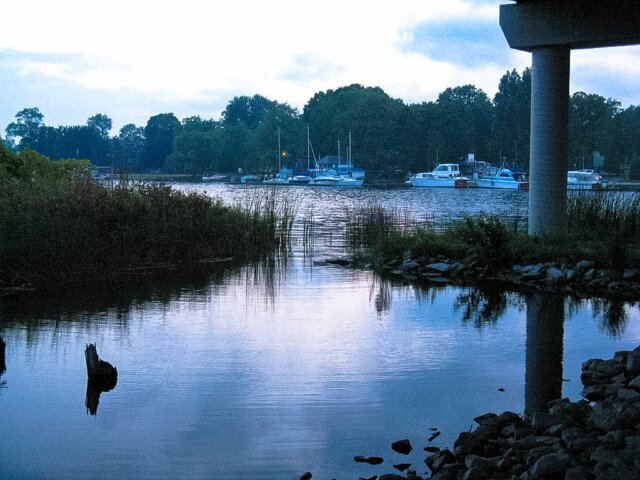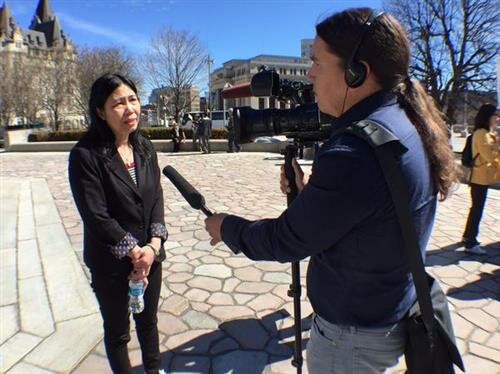The freedom to limit freedom of the press
Some Indigenous band councils are banning journalists, challenging freedom of the press guaranteed by the Charter of Rights and Freedoms. Are they protecting their communities from harm, or protecting themselves from scrutiny?
In March 2016, scandal erupted in a small reserve in Alberta’s prairie country. Kurt Burnstick, chief of Kipohtakaw (Alexander First Nation), was charged with sexual assault.
The arrest made the news across Canada — politicians charged with sex crimes often do — but barely. Global News mustered 85 words. CBC managed less than 300. Most of the stories were little more than summaries of the RCMP press release.
The initial story was minimal, but before it could develop, another press release was published, this time by Kipohtakaw. It announced “a complete and total media blackout.” Any journalists caught on the reserve would be charged with trespassing.

The blackout was issued by the band council, which is led by the chief who is also the accused. The release stated that the blackout was in response to “negative impacts” of media’s “biased and uninformed statements.” The CBC posted the press release on its site.
For a time, journalists seemingly accepted the ban and didn’t continue to report on the story. On Sept. 6, the band released another statement, reversing the blackout because it was “unconstitutional” and “done without proper legal advice.”
This opens up a story of its own. It’s one familiar to those who live in the constellation of more than 3,000 reserves across the country and to those journalists who have attempted to cover these communities. In the age of reconciliation, should First Nations have the right to impose media bans? Are Indigenous leaders overruling the Charter of Rights and Freedoms in order to protect their communities from harm, or to protect themselves?
Media blackouts as harm prevention
In the spring of 2016, Justin Trudeau was nearly unaccompanied by media when he visited Shoal Lake 40 First Nation, which straddles the southern border of Manitoba and Ontario. VICE Canada was the only media presence allowed into the community. Treaty 3 police kept the rest of the media at bay. Media relations officer Cuyler Cotton said the community didn’t want a “media circus,” according to the CBC, which was also denied access.
Similarly, a media ban was imposed when tragedy struck on the Yellow Quill Reserve in Saskatchewan in 2008. A father became separated from his children when walking with them late at night in the deep, cold prairie winter. The two children were later found dead, having succumbed to hypothermia.
The reserve imposed a media ban on the memorial service, enforced by the RCMP. (However, a judge denied the community’s request for a media ban on the traditional healing circle sentencing the accused.)
In 2002, the Chippewas of Rama First Nation in Ontario held an all-candidates meeting to discuss an upcoming band election. The media was barred from covering the proceedings. Chief Sharon Stinson Henry said the band membership considered the proceedings a private matter and they preferred not to deal with “the whole world.”
“A First Nation is not like any other community,” she told The Barrie Examiner. “We function more as a private corporation.”
"Traditionally, First Nations have only been exposed to media when there has been a tragedy in the community, so there's a deep-seated mistrust."
The rationale for media bans is typically to respect cultural protocol, respect private community affairs and protect communities from journalistic harm.
Preventing harm is the reasoning most commonly used when instituting a media blackout. Media blackouts are an ostensibly preventative measure: a material response to the harms mainstream media has committed against Indigenous communities.
There has been a long history of media missteps when it comes to coverage of Indigenous affairs. Stereotyping, racial slurs and coverage that deals solely with what journalist Duncan McCue calls the “four Ds” — dancing, drumming, drunk or dead — are regular reminders of mainstream media’s poor performance record.
But while proponents of media bans — byproducts of this long line of media shortfalls — justify them as protecting the community, cases like the Kipohtakaw media ban show how they can also be used by embattled officials to evade scrutiny.
Publishing despite the ban: Not illegal, not ethical
Perhaps, then, this legal grey area ought to be preserved to allow journalists to hold First Nations to account.
But the pendulum could swing the other way — without legal protection against media infringement on cultural or private matters within a community, Indigenous peoples are being forced to accept a colonial framework that does not accommodate their cultural practices.
It’s an ongoing tension that’s felt by Waubgeshig Rice, a video journalist with CBC Ottawa and member of the Wasauksing First Nation.
“I come from both worlds. I'm from a First Nation and I'm part of the mainstream media, so when those worlds collide, I definitely see arguments for both sides,” he says.
Since he has been working as a journalist, Rice has noticed a change in how Indigenous communities approach the media — they are more open and willing to share. But not always, and, Rice says, for good reason.
“Traditionally in Canada over the past few decades, First Nations have been exposed to media when there has been a tragedy in the community, and when the media has visited just for those reasons, so there's a deep-seated mistrust. When I hear stories of communities not allowing media access, I relate to them, or empathize, even, because I've seen similar things happen within my own community.”

The constitutional protections for media blackouts in communities like Rice’s and Kipohtakaw First Nation are limited. But these bans also mean that what happens on reserves — especially when it comes to elections and other administrative processes — might not be fairly scrutinized by the public, which is something Rice also wrestles with.
“From a journalistic standpoint, you're usually frustrated when you're trying to do a story like that and hold people accountable and get to the core of the issue.”
Constitutionally, First Nations are guaranteed the freedom to exercise their culture and inherent rights. Reserves provide the protection against mainstream infringement on their lands, and news media represents the window through which to cross that divide. But perhaps, as Rice points out, those being seen ought to be able to draw the blinds.
“It's important for media to realize and understand that they are not owed anything by a community and access really isn't public space,” says Rice. “It's reserve land that's been outlined by a treaty made with Canada.”
Building legal grounds for bans
David Milward is a law professor and member of the Beardy’s & Okemasis First Nation. He studies how the Charter of Rights and Freedoms intersects with treaty rights.
Milward points out that the legality of media blackouts on First Nations reserves hasn’t been tested by the courts. “I’m not aware of any specific provision in the Indian Act that authorizes a media blackout as such,” he says.
He explains that while it’s possible for certain laws to hold sway over the charter thanks to the “reasonable limits clause,” it can only happen if the Crown can prove there is a justifiable purpose.
In the case of a media blackout on a First Nations reserve, then, a journalist’s right to free expression could only be hindered if a specific law exists that could reasonably limit that freedom.
"The reserve would have to articulate what Aboriginal right is at stake that justifies a media ban."
There is no legal mechanism that allows non-Indigenous communities from imposing media blackouts. So what makes a First Nations community any different?
The Indian Act and Section 35 of the Charter of Rights and Freedoms provide a unique set of rules that apply specifically to Indigenous people and that might be used in the instance where the limitation is prescribed by law, says Milward.
Milward cites Section 30 of the Indian Act, which deals with trespassing, and is essentially intended to protect the independence of First Nations reserves.
According to the Indian Act, “a person who trespasses on a reserve is guilty of an offence and liable on summary conviction to a fine not exceeding fifty dollars or to imprisonment for a term not exceeding one month or to both.”
This means that an uninvited representative of the media can be told, legally, to leave a reserve.
But Milward is skeptical that the trespass law could trump a journalist’s right to free expression.
“[This is] partly because the trespassing bylaw has a certain objective to it, and that is to allow tribal or Indian bands to preserve the territorial integrity of the reserve to prevent outsiders from coming in and causing actions to be detrimental to the best interests of the tribal community,” he says.
But in the case of media blackouts, says Milward, the trespass section of the Indian Act does not hold water. “Here it’s being used in a roundabout way to enforce a media blackout, so in some respects the objective there is itself questionable.”
The last possible means of defending the legal permissibility of these blackouts, according to Milward, can be found in Section 25 of the Charter of Rights and Freedoms. It states: “The guarantee of this Charter of certain rights and freedoms shall not be construed as to abrogate or derogate from any Aboriginal, treaty or other rights and freedoms that pertain to the Aboriginal peoples of Canada.”
Basically, journalists can’t infringe on Aboriginal or treaty rights.
According to Milward, if that is being used as a justification, the reserve would “have to articulate what Aboriginal right is at stake here that justifies a media ban.” More often Section 25 gets invoked when dealing with ancestral claims such as fishing rights, says Milward.
So until these legal contradictions are tested in a court of law, the legality of media blackouts in Indigenous communities will remain murky.
This is the fourth article in a five-part investigation into freedom of the press in First Nations. Read the whole series:
1. In First Nations, freedom of the press is unclear
Treaties are no guarantee of freedom of the press — but there’s little media coverage in First Nations anyway.
Thirty-five stories that are unlikely to ever see the light of day.
3. FOI laws don’t apply to most First Nations
Only a handful of more than 600 First Nations in Canada have laws that grant their members and the public access to information.
4. The freedom to limit freedom of the press
Some Indigenous band councils are banning journalists, challenging freedom of the press guaranteed by the Charter of Rights and Freedoms. Are they protecting their communities from harm, or protecting themselves from scrutiny?
First Nations community members are pushing for post-treaty freedom of the press — but a lack of journalism training opportunities is holding back those trying to hold their governments to account.
